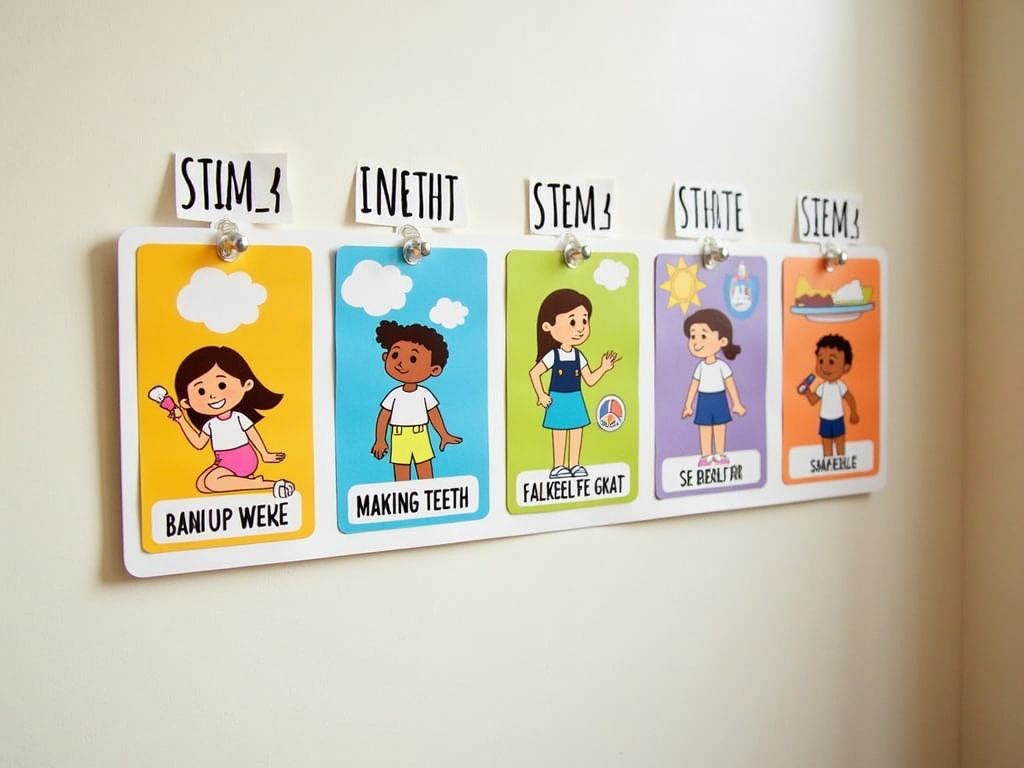Visual schedules use pictures or symbols to guide kids through daily tasks. They boost independence, ease anxiety, and smooth transitions—perfect for any child, especially those with special needs.
What Are Visual Schedules?
A visual schedule shows a sequence of tasks using images, symbols, or words. Think of it as a roadmap for a child’s day—like a morning routine with pictures of waking up, brushing teeth, and eating breakfast. These tools shine for kids with autism, ADHD, or other needs, but they work wonders for all children by making routines clear and predictable.
Why They Work
- Independence: Kids follow steps without nagging.
- Less Worry: Seeing what’s next calms nerves.
- Better Communication: Pictures help when words fail.
- Learning Made Easy: Visuals turn ideas into something tangible.

How to Create Visual Schedules That Kids Love
Making a visual schedule is simple and fun. Tailor it to your child’s needs with these steps:
- Pick a Routine: Focus on one—like bedtime or mornings.
- Break It Down: List small steps (e.g., wake up, brush teeth).
- Find Images: Use photos, drawings, or clipart—add words if they read.
- Set It Up: Arrange images on a board, binder, or app.
- Add Interaction: Use Velcro or checkboxes for kids to mark tasks.
- Practice Together: Walk through it until they get the hang of it.
Make It Fun
- Bright Colors: Grab their attention with vivid visuals.
- Their Favorites: Love cars? Use car-themed images.
- Keep It Clear: Simple images, fewer steps.
- Stay Steady: Same style builds trust.
Real Examples
| Type | Example Steps |
|---|---|
| Daily Schedule | Wake, school, play, dinner, bed |
| Task-Specific | Water on, soap, scrub, rinse, dry |
| Choice Board | Read or play outside |

How to Create Consistent Routines for Children
Kids thrive on routine. It’s like an anchor—giving them security and teaching self-control. Visual schedules lock in that consistency with a clear guide they can see anytime. For kids with special needs, this cuts confusion and meltdowns.
Applied Behavior Analysis Strategies for Parents
Applied Behavior Analysis (ABA) is a science of behavior and learning. It’s the backbone of behavioral therapy, helping kids build good habits. Parents can use it with visual schedules like this:
- Rewards: Praise or a sticker for finishing tasks.
- Hints: Point to the picture to keep them on track.
- Step Back: Ease off help as they master it.
- Track It: Note what works to tweak the plan.
My Story
My daughter used to dread mornings—rushing and forgetting things. I made her a visual schedule with unicorn pictures (her obsession). Suddenly, she was up, dressed, and ready without a fuss. The first time she checked off every box herself, her grin said it all—pure pride.

Tips to Make It Stick
- Start Easy: Try one routine first.
- Get Them In: Let them pick pictures or decorate.
- Be Patient: It takes time—keep cheering.
- Tweak It: Change what doesn’t work.
- Celebrate: High-five every win.
Wrapping Up
Visual schedules turn chaos into calm. They guide kids with clear steps, build confidence, and keep routines steady. With a dash of creativity and ABA tricks, they’re a win for any family. Try it—you’ll see the magic happen.
Discuss Here